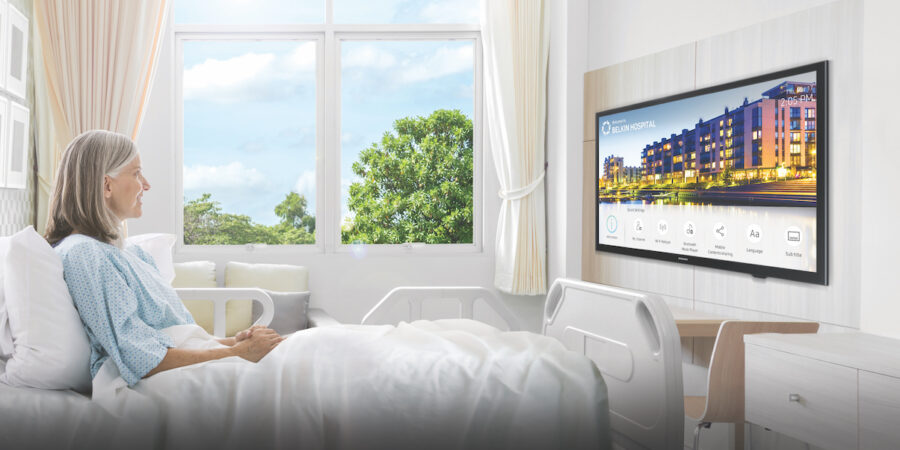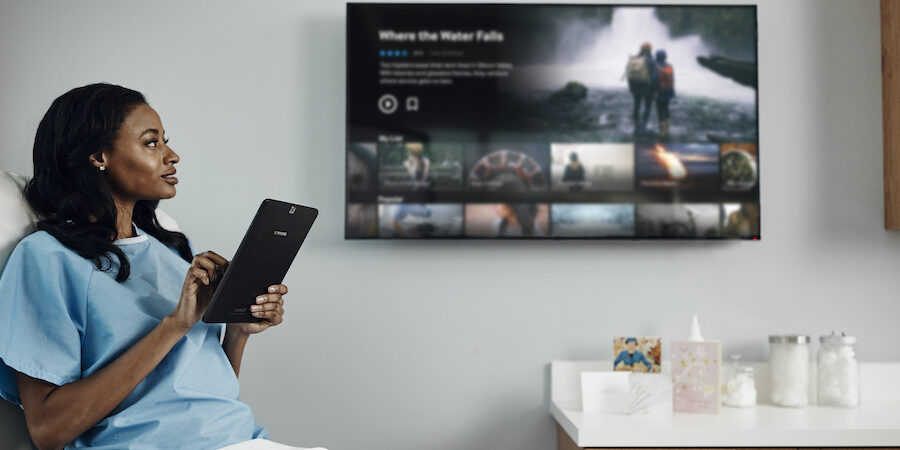Thanks to tremendous leaps in technology, hospital patient TV systems can now do so much more than simply offer entertainment and distraction. This includes treating every patient as a guest and having the ability to reduce the workload for nurses and staff.
Samsung healthcare TVs are a great example. The latest models transform the ubiquitous television into an all-in-one communication hub, enhancing patient engagement and workflow efficiency for nursing staff while providing a host of other benefits.
Healthcare TV use cases
Here are some of the top reasons hospitals are implementing Samsung healthcare-grade TVs:
Provide customized education
As soon as the patient is admitted into their room, the TV can tailor content specific to that patient. For example, educational videos specific to the patient’s condition and care plan can be displayed for them to watch and review — all in their preferred language. Furthermore, these videos can be accessed on-demand, 24/7.
Once the patient has watched the video and reviewed these educational materials, the electronic health record (EHR) can record that. This EHR integration is achieved by Samsung Interactive Patient Care (IPC) software partners, coupled with Samsung healthcare TVs, such as Samsung HCU7030 Series Crystal Hospital TV and Samsung Smart QLED HCF8000 TV.
Improve and assess patient satisfaction
Smart TVs can enhance the patient care experience, and improving the in-room experience leads to higher scores in the Hospital Consumer Assessment of Healthcare Providers and Systems (HCAHPS) and greater hospital reimbursements.
Collecting patient feedback is also essential to a hospital’s HCAHPS score. With Samsung healthcare-grade TVs, that feedback becomes easier to collect, as a survey on the TV prompts patients to provide real-time feedback on their hospital stay. This patient response is critical to improving future patient experiences.
Relieve nurse call button fatigue with a digital concierge
When patients are entertained and engaged, they are less likely to call the nurses’ station. This decreases call-button fatigue for nurses while at the same time making them more available and focused for more critical and challenging situations. When patients do need help, Samsung healthcare TVs facilitate that, too. They allow patients to request both clinical and non-clinical items or services, such as physical assistance, a chaplain, more bedding, and meals and beverages.
Provide distraction
For all this sophistication, it’s important to remember that TVs provide an important distraction through entertainment, be it TV shows, movies or music. By doing so, they help alleviate pain, discomfort and anxiety. The more options patients have, the greater the possibility of attaining that alleviation.
Create the patient room of the future — today
Explore key technologies for enhancing patient experience and care while supporting staff. Download Now
Improve entertainment and efficiency
Samsung HCU7030 Series Crystal Hospital TV can display several types of content at once. Some of the screen space can serve as a digital whiteboard while still allowing plenty of screen space for patient entertainment. The system is sophisticated but not complex: Patients can easily navigate from education to entertainment and from telehealth appointments to meal ordering.
Paired with a wide array of telehealth camera and software partners, Samsung healthcare TVs can even facilitate telehealth visits for doctors needing to do virtual rounds and nurses monitoring patient care remotely.
Hospitality in the hospital
For patients craving the luxury hospitality experience, Samsung HCU7030 TVs come in sizes up to 75 inches, and the 4K upscaling delivers superior visuals. Especially important for patients, these TVs enable clear streaming audio without headphones. Furthermore, with the pillow speaker interface, they can control the sound and video right from their bed, giving patients a high-definition viewing experience similar to home, including the ability to cast from their phone or tablet to the in-room TV.
These patients also don’t want to deal with reams of paper, either. Handbooks, channel guides, welcome videos, food menus and more can be digitally displayed on the system without all the physical clutter. Delivering information digitally means that updates can be made and displayed in real time, too, ensuring everyone has the same information.
Fit for purpose
Sometimes, a 75-inch television simply isn’t feasible. Consider infusion suites and dialysis centers — there’s no room for a large screen. With a 32-inch screen, Samsung HCF8000 TV solves this problem. Its compact design seamlessly blends into any setting while maximizing space. This includes double occupancy rooms, infusion bays and emergency department (ED) rooms. For example, some hospitals have built them into the soffit over the ED beds. Pediatric rooms typically feature a parent enclave with a small sofa or bed and a TV, and HCF8000 TV can be ideal for these areas.
Better care, engaged patients, happier staff
By putting patients in control, Samsung healthcare-grade TVs coupled with Interactive Patient Care platforms lighten the burden on nurses and other staff members. No longer do patients need to push the nurse call button to ask what their care plan is for the day, because their personalized care schedule is already displayed on the TV. The same goes for discharge instructions and other daily activities.
Optimizing workflow by letting the TV do the work leads to less burnout and turnover in the nursing staff. In turn, morale is improved, which makes them better at caring for their patients. The smart room technology gives you the tools to treat your patients as guests, improving their experience while reducing the burden on nurses and staff. That’s good for your organization, your team, and your patients.
Learn more about the benefits Samsung digital signage provides hospitals. Also, discover how hospital leaders can improve patient outcomes in this free guide.









